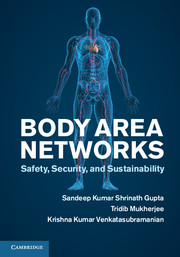Book contents
8 - Epilogue
Published online by Cambridge University Press: 05 April 2013
Summary
A decade ago wireless sensor networks (WSNs), resulting primarily from developments in miniaturization and low-powered electronics, opened up the possibility of deploying computing capabilities ubiquitously. Not surprisingly, the last few years have seen the extension of this capability to the human body, leading to the development of body area networks (BANs), which are networks of medical devices and sensors worn on or implanted in the human body. They are used for monitoring and actuation purposes and typically applied in, but not limited to, medical settings. In this book we have aimed at providing a systematic description of how to design and develop safe, secure, and sustainable BANs. We have focused on ideas heretofore available only in scattered research articles and development guides for open-source sensor platforms. Our hope is to bring the latest technological developments in the domain of BANs to a wider audience.
Body area networks are becoming increasingly vital for nations and societies worldwide, especially in an attempt to reduce the burgeoning healthcare costs. In this book we have attempted to give a cohesive account of (i) their principal components, properties, and characteristics; (ii) the need for safe, secure, and sustainable design of BANs and the approaches available for addressing this need; and (iii) experiences with, and issues involved in, implementing actual BANs, drawing on lessons learnt from actual implementation. So far, the major focus of the BAN community has been on developing the hardware platforms and basic signal-processing techniques for BANs.
- Type
- Chapter
- Information
- Body Area NetworksSafety, Security, and Sustainability, pp. 119 - 120Publisher: Cambridge University PressPrint publication year: 2013



